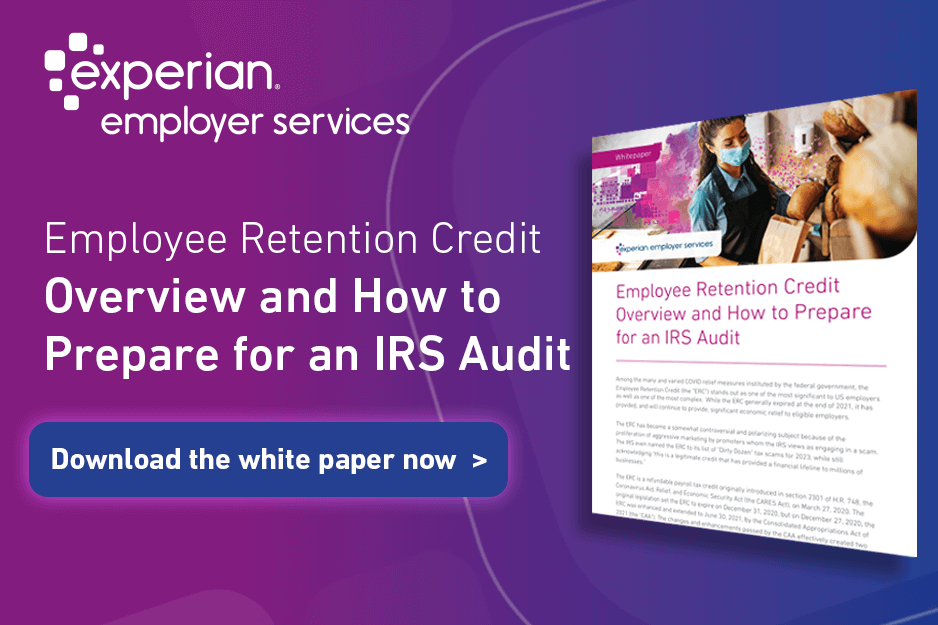 The COVID-19 pandemic has financially impacted many businesses over the past two years. While no government program will likely be able to fully make up the profits lost by facility shutdowns and overall loss of business, the Employee Retention Credit (ERC) can help provide significant relief. The program was established under the Coronavirus Aid, Relief, and Economic Security Act (CARES) to incentivize eligible businesses to maintain employees on the payroll and to sustain the business through the financial crisis caused by the pandemic. Changes to programs and incentives for businesses have left many needing help understanding ERC qualifications. Many companies have overlooked ERC as an option for relief because the CARES Act initially prevented employers from receiving both a Paycheck Protection Program (PPP) loan and the ERC. This has since changed. In addition, the Infrastructure Investment and Jobs Act retroactively ended the ERC program on Oct. 1, 2021, so employers can’t participate in the ERC for Q4 2021. However, while the program expired on Sept. 30, 2021, businesses can retroactively claim the ERC on their 2020 and 2021 payroll tax returns and take advantage of the resulting cash relief and large credit amounts. In order to do so, businesses must understand how this program works, who qualifies for the ERC and how to claim it.
The COVID-19 pandemic has financially impacted many businesses over the past two years. While no government program will likely be able to fully make up the profits lost by facility shutdowns and overall loss of business, the Employee Retention Credit (ERC) can help provide significant relief. The program was established under the Coronavirus Aid, Relief, and Economic Security Act (CARES) to incentivize eligible businesses to maintain employees on the payroll and to sustain the business through the financial crisis caused by the pandemic. Changes to programs and incentives for businesses have left many needing help understanding ERC qualifications. Many companies have overlooked ERC as an option for relief because the CARES Act initially prevented employers from receiving both a Paycheck Protection Program (PPP) loan and the ERC. This has since changed. In addition, the Infrastructure Investment and Jobs Act retroactively ended the ERC program on Oct. 1, 2021, so employers can’t participate in the ERC for Q4 2021. However, while the program expired on Sept. 30, 2021, businesses can retroactively claim the ERC on their 2020 and 2021 payroll tax returns and take advantage of the resulting cash relief and large credit amounts. In order to do so, businesses must understand how this program works, who qualifies for the ERC and how to claim it.
ERC Eligibility: Who Qualifies for the ERC?
The ERC is available to trades or businesses whose operations were subject to a full or partial suspension of operations due to governmental orders, or who experienced a significant decline in gross receipts during the pandemic. Key ERC eligibility and calculation rules vary for calendar years 2020 and 2021.
ERC Qualifications for 2020
Employers are eligible to claim the ERC for the calendar year 2020 if they operated a trade or business during the calendar year and experienced either:
- A full or partial suspension of the operation of their trade or business during any calendar quarter on account of a governmental order limiting commerce, travel or group meetings due to COVID-19; or
- A significant decline in gross receipts by more than 50 percent when compared to the same quarter in the prior year.
The maximum amount of qualified wages taken into account concerning each employee for all calendar quarters is $10,000, and the maximum credit for an employer who qualifies for the ERC is 50 percent of the first $10,000 in qualified wages, i.e., up to $5,000 per employee.
For an employer who on average had more than 100 full-time employees in 2019, qualified wages are generally those wages paid to employees not providing services because operations were fully or partially suspended or due to the decline in gross receipts.
For an employer who on average had 100 or fewer full-time employees in 2019, qualified wages are generally those wages paid to all employees during a period that operations were fully or partially suspended or during the quarter that the employer had a decline in gross receipts, regardless of whether the employees are providing services.
For both large and small employers, “wages” are defined as taxable wages including certain contributions to health benefit plans.
Related: Do You Qualify for the ERC? Busting 5 Myths
ERC Eligibility for 2021
Effective Jan. 1, 2021, employers are eligible to claim the ERC if they operated a trade or business during 2021, and experienced either:
- A full or partial suspension of the operation of their trade or business during a calendar quarter on account of a governmental order limiting commerce, travel or group meetings due to COVID-19; or
- A decline in gross receipts in the first, second or third calendar quarter in 2021 where the gross receipts of that calendar quarter are less than 80 percent of the gross receipts in the same calendar quarter in 2019.
For the calendar year 2021, eligible employers can claim a credit of up to 70 percent of qualified wages paid to employees after Dec. 31, 2020, and before Oct. 1, 2021. For 2021, the credit is equal to 70 percent of the first $10,000 in qualified wages per quarter, i.e. up to $7,000 per employee per quarter. As a result, an employer who qualifies for the ERC can get a maximum credit of $7,000 per quarter per employee, a total of $21,000 for 2021.
Employers in U.S. Territories: ERC Eligibility
The ERC is a valuable tax credit employers may claim to help offset some of the hardships they may have experienced due to the coronavirus pandemic. When it comes to ERC eligibility, you might be wondering: Are employers in the U.S. territories eligible to claim the ERC? Fortunately, yes. If you’re an employer operating in a U.S. territory or commonwealth, you can claim the ERC.
According to the IRS, Section 2301(c)(5)(A) of the CARES Act uses Section 3121(a) of the Federal Insurance Contributions Act to determine eligibility and qualifying wages. Wages that employees earn from employers in U.S. territories are subject to FICA taxes, meaning that employers that issue qualifying wages could be eligible to receive the ERC if they meet all of the eligibility requirements.
The IRS further clarified this conclusion in IRS Notice 2021-20 Question 4:
- Question 4: Are employers in U.S. Territories eligible for the employee retention credit?
- Answer 4: Yes. If an employer in a U.S. Territory otherwise qualifies for the ERC then the employer is entitled to claim the credit. Section 2301(c)(5)(A) of the CARES Act provides that qualified wages are, in general, wages as defined in section 3121(a) of the Code for purposes of the Federal Insurance Contributions Act (FICA) tax. Payments of wages by employers in U.S. Territories are wages within the meaning of section 3121(a). Accordingly, eligible employers include employers in the U.S. Territories that pay qualified wages and otherwise meet the requirements for the credit.
Current U.S. territories and commonwealths include:
- Puerto Rico
- U.S. Virgin Islands
- American Samoa
- Commonwealth of the Northern Mariana Islands
- Guam
If you’re an employer in a U.S. territory or commonwealth that meets the ERC eligibility requirements, you could be eligible to claim the credit. To be considered as an eligible employer, an employer must have operated a trade or business in 2020 or 2021 and experience one of the following:
- A complete or partial suspension of trade or business operations during a calendar quarter due to a government order restricting commerce, travel or group meetings as a result of COVID-19, or
A drop in gross receipts in the first, second or third calendar quarter of 2021, resulting in that quarter’s gross receipts falling below 80 percent of those in the corresponding quarter of 2019.
If you meet these requirements, you may be able to claim the ERC. It’s important to note that you can still claim the ERC in 2023 and in 2024. The deadline to claim the credit for all quarters for the 2020 tax year is April 15, 2024, while the deadline to claim the ERC for all quarters of the 2021 tax year is April 15, 2025.
To claim the ERC as a business operating in a U.S. territory, you will amend your previously filed Form 941 by filing form 941-X, similar to how businesses in a U.S. state will file. When filing, it’s important to ensure you’re making accurate calculations and estimations when applying for your credit amount to prevent an underpayment of your tax liability resulting in penalties. Working with a tax expert like Experian Employer Services, you can have peace of mind knowing you’re compliant.
At Experian Employer Services, our tax credit services can help you determine your eligibility for this credit and comply with appropriate laws and regulations. Unfortunately, there are third-party ERC schemes that may advise you to claim the ERC when your organization doesn’t qualify. At Experian Employer Services, our team will carefully review relevant documentation and supporting materials to ensure compliance and correctly claim the ERC if you are eligible.
Understanding Who Qualifies for the ERC
To determine eligibility based on a decline in gross receipts, employers compare the quarter in 2020 or 2021 to the same quarter in 2019. For example, an employer looking to determine eligibility for the ERC in Q2 2021 would compare its gross receipts in Q2 2021 to its gross receipts in Q2 2019.
Employers can elect to use an alternative quarter to calculate gross receipts. Under this election, an employer can determine if the decline in gross receipts test is met for a calendar quarter in 2021 by comparing its gross receipts for the immediately preceding calendar quarter with those for the corresponding calendar quarter in 2019. For example, an employer with a substantial decline in gross receipts in Q1 2021 (as compared to Q1 2019) would be eligible in Q1 2021 and Q2 2021 based on the Q1 comparison.
For an employer who qualifies for the ERC based on the governmental order requirement, it is necessary that business operations were fully or partially suspended during the applicable calendar quarter due to a governmental order limiting commerce, travel, or group meetings due to COVID-19. At the same time, the governmental order test does not require a decline in gross receipts for an employer to be eligible.
There are various factors to consider when assessing eligibility under the governmental order test, which often depends on whether a company experienced a partial suspension. Generally, a partial suspension of operations means that either:
- More than a nominal portion of business operations is suspended by a governmental order and those operations can’t be performed remotely in a comparable manner; or
- Business operations continue, but the operations are subject to modification due to a governmental order that has more than a nominal effect on the business operations.
When Can You Claim the ERC?
If you need to claim the ERC, there is still time. For companies that meet the ERC eligibility requirements, you can claim the ERC up to three years after filing your tax return or up to two years after paying, whichever comes later. This can be done by filing Form 941-X, Adjusted Employer’s Quarterly Federal Tax Return or Claim for Refund. Form 941-X also can be used to report any errors or mistakes. You can file claims for unclaimed credits for 2020 until April 15, 2024, and for 2021 until April 15, 2025.
Preventing Missed ERC Opportunities
Even though many employers who otherwise qualified for the ERC missed claiming the credit, there is still time to file amended employment tax returns and take advantage of the ERC. The statute of limitations for filing amended quarterly returns is generally three years from the date of filing Form 941. Per Form 941-X instructions, the period of limitations to amend the form begins on April 15 of the succeeding year in which the form was filed. For example, to apply for the ERC for Q2 2021, and assuming the original Form 941 was filed timely, the amended return must be submitted by April 15, 2025.
However, to minimize risk during the claims process, employers must understand who qualifies for the ERC and other nuances of ERC eligibility and claims. Further, keeping appropriate documentation is necessary for meeting all compliance requirements. Employers can outsource the entire process to successfully navigate the ERC’s obligations. As a result, they can maximize the ERC and its benefits by relying on up-to-date technology solutions and tax credit specialists who help employers identify if businesses qualify, claim the full amount of the credit and ensure proper payroll tracking and documentation.
Take advantage of the ERC benefits and get full support with determining your company’s eligibility, detailed calculations and filing logistics.
ERC Eligibility FAQs
What Are ERC Qualified Wages?
Qualified wages are wages or compensation paid by an eligible employer to some or all of its employees after March 12, 2020, and before Oct. 1, 2021, and also include the eligible employer’s qualified health plan expenses allocated to these wages. However, the term “qualified wages” varies depending on the number of full-time employees employed by the business.
For businesses with more than 100 full-time employees, qualified wages refer to the wages given to an employee for time the employee was not performing services due to a government order that either entirely or partially suspended the employer’s business activities or a significant drop in gross receipts. For businesses with 100 or fewer full-time employees, qualified wages are wages paid to any employee during a time when business operations were completely or partially halted due to a governmental order or when the company’s gross receipts significantly dropped.
Do You Include Tipped Wages in Qualified Wages?
Tips are only included in qualified wages if the tips are subject to FICA taxes. Typically, this means tips must exceed $20 for a calendar month for an employee. However, if tips amount to more than $20 for a calendar month, all tips, including the first $20, are considered qualified wages.
What Is Considered a Large Employer and Small Employer Under the ERC?
ERC credit qualifications vary slightly depending on the size of your business. Whether you’re considered a large or a small employer depends on the number of employees you have on your payroll.
- For the 2020 ERC, small employers are businesses with 100 or fewer full-time employees.
- For the 2021 ERC, small employers are businesses with 500 or fewer full-time employees.
- For the 2020 ERC, large employers are businesses with more than 100 full-time employees.
- For the 2021 ERC, large employers are businesses with more than 500 full-time employees.
When examining the size of your business, it’s essential to know who qualifies for the ERC as a full-time employee. Under the IRS, a full-time employee is an employee who works 30 hours or more per week or 130 hours per month, according to IRC 4980H.
Is ERC Eligibility Only for Full-Time Employees?
No. When calculating the ERC, an employer can include wages given to part-time and full-time workers, but can only compute the credits on the first $10,000 in salary and health plan expenses paid to each employee during each credit-generating period.
Who Qualifies for the ERC?
A wide range of businesses that can meet the ERC eligibility requirements. Some of the industries that can meet the ERC eligibility qualifications include:
- Construction
- Restaurant
- Hospitality
- Education
- Government
- Industrial
- Not-for-profit
- Real estate
- Technology
At Experian Employer Services, our team can help businesses across various industries claim the ERC.
Can Churches and Religious Organizations Claim the ERC?
Yes, churches and religious organizations can claim the ERC. For example, you may meet ERC qualifications if you operate a church or religious organization impacted by government-ordered capacity restrictions on gatherings or suffer a significant drop in gross receipts.
Can You Claim Other Tax Credits Along With the ERC?
In most cases, “double-dipping” is not allowed, which means you can’t take a credit on qualified wages for the ERC and certain other tax credits, such as Paid Family Medical Leave or the Work Opportunity Tax Credit (WOTC). For the ERC, businesses can only claim the credit on wages that are not forgiven or expected to be forgiven by the PPP. If you have questions about maximizing your return, consult our team at Experian Employer Services. We can help you maximize your return while remaining completely compliant so you can improve your bottom line.
How Long Does It Take to Receive the ERC?
After meeting ERC qualifications and filing Form 941-X with the IRS, you will be able to receive a refund, but the IRS does not provide a timeframe for how long it will take to receive that refund. An important component affecting the time to receive the ERC is the backlog of Forms 941-X.
Understand Your ERC Eligibility With Experian Employer Services
At Experian Employer Services, we offer tax credit services to help you claim tax credits that can save you money. In addition, with our team of professionals on your side, you can outsource the entire ERC process to free up time, so your team can focus on other areas of your business.
Along with ERC eligibility, we can help you claim and process a wide range of other tax credits, including the Work Opportunity Tax Credit, Research and Development Tax Credit, Disaster Zone Tax Credit, Family Medical Leave Act Tax Credit and more. To maximize your return and boost your bottom line, request a demo with Experian Employer Services today.



